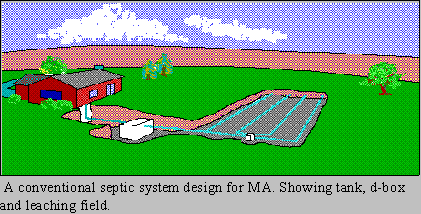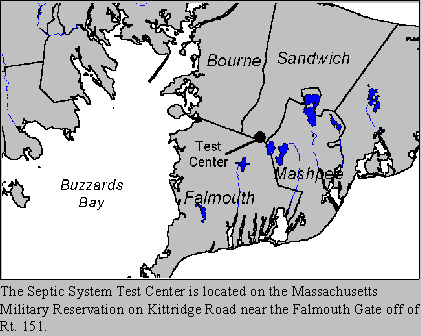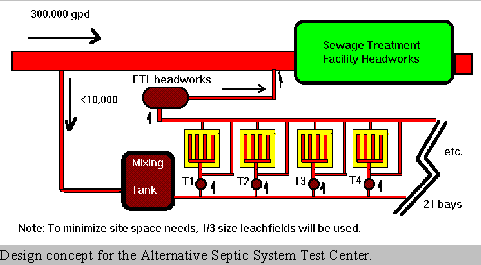Massachusetts Alternative Septic System Test Center Fact Sheet: Test Center Basics

Introduction
In September of 1996, the Buzzards Bay National Estuary Program –a unit of the Massachusetts Office of Coastal Zone Management within the Executive Office of Environmental Affairs– received a U.S. EPA Environmental Technologies Initiative (ETI) grant to design, construct, and operate a testing center for alternative and innovative onsite wastewater treatment technologies (septic systems). The grant application was actually submitted jointly with the Barnstable County Department of Health and the Environment (BCDHE), and was endorsed by the Massachusetts Department of Environmental Protection (DEP). Additional funding and in-kind assistance for the construction of the facility was provided by MA Department of Environmental Protection, Massachusetts Environmental Trust, Massachusetts Coastal Zone Management, ComElectric, Endeco/YSI, F.E. Myers, and Wiggins Precast.
The facility was designed by Phelps Engineering of Middlebury, VT, and built by Engineered Construction of Hyannis at a site on the Otis Air National Guard Base on Cape Cod, MA. Completed in the fall of 1998, the facility began testing conventional and innovative septic systems. For the first two years following construction, the Test Center was operated the Buzzards Bay NEP, but this responsibility was transferred to the BBCDHE in 2000. Throughout its existence, the DEP has worked with the Test Center to ensure it meets the needs of the Commonwealth.
Oversight for the development and construction of the Test Center was initially provided by a steering committee with representatives from MA DEP, US EPA, The Department of the Air Force and the Massachusetts Air National Guard, MA CZM, Barnstable County Department of Health and the Environment, CMAST, New England Interstate Water Pollution Control Commission (NEIWPCC), the University of Rhode Island (URI), Cape Cod Community College, the Town of Sandwich, MA, and the Town of Falmouth, MA. With the completion of the Test Center, a smaller data management committee composed of Barnstable County, DEP, the Buzzards Bay NEP, and Coastal Zone Management meet regularly to discuss state and local information needs, and progress and activities at the facility
Why do we need a Septic System Test Center?
Approximately 40% of the residences in Massachusetts are served by onsite wastewater systems. Conventional septic systems are designed to address primarily bacterial removal and decay of organic wastes, and have changed little over the past 20 years. However, conventional septic systems do little to remove nitrogen, which can be a concern for both drinking supplies and a threat to coastal waters. Conventional systems may also be prohibited where groundwater levels are high, or in certain soil types. In these cases, alternative septic system designs may be desirable.
The partners in the Test Center recognized that effluent from conventional septic systems was a major contributing factor to the decline of water quality in surface waters in general and in particular, onsite-derived nitrogen as transported by groundwater was contributing to coastal eutrophication. It was also clear that technologies existed which provided more advanced contaminant removal, and which could improve surface water and groundwater quality. However, these technologies had been slow to find regulatory and commercial acceptance in the New England region partly because of the scanty and uneven quality of performance data and the time and cost required to generate data that was acceptable to regulators.

The Mission of the Test Center
As a US EPA Environmental Technology Initiative project, the Test Center’s primary goal is to speed the introduction and approval of innovative advanced onsite wastewater disposal technologies in Massachusetts. Our hope is that this will lead to varied and economical alternatives to the conventional septic system, with improved benefits to the environment.
To accomplish this, the Test Center is providing independent, rigorous testing programs to measure the performance of onsite technologies, which are conducted under controlled conditions for a testing period of two years. The Test Center provides vendors of innovative onsite technologies with both the opportunity to accelerate Massachusetts’ regulatory approvals and to reduce the substantial cost of the monitoring necessary to receive permits for the sale of onsite systems in Massachusetts. For example, vendors who successfully participate in the Test Center may satisfy the requirements for “Piloting” for new technologies under the state Title 5 sanitary regulations, resulting in a simplified piloting approval. Data generated at the Test Center will also be useful to onsite vendors in obtaining approvals elsewhere in the Northeast. To disseminate information to professionals and consumers, the Test Center issues reports, conducts workshops, and investigators present papers at meetings.
Testing Facility Operation and Monitoring
The facility has the capacity to test six residential treatment technologies in triplicate, along with three conventional septic systems that serve as a benchmark for the other technologies. Additional spaces are available to test leachfield and septic system technologies.

Using residential wastewater from a sewer at Otis ANGB, equal amounts of sewage is pumped to each technology. The facility was designed to preventing releases of raw or treated wastewater to groundwater, and effluent from each technology flows to one-quarter size underlined, leach trenches where the removal of pathogens and biochemical parameters beneath the leach trench are measured. Under the ETI program, the BBP, BCDHE, and the University of Massachusetts at Dartmouth, and EPA developed the monitoring plan with guidance from the EPA. Samples are taken at critical locations in the flow stream including the influent raw sewage, technology effluent and soil absorption field leachate. Most analytical work will be conducted nearby: measurement of organic and pathogenic contaminants will occur at the laboratory of the Barnstable County Department of Health and the Environment. UMass Dartmouth initially conducted the nutrient monitoring, but a private contractor now provides these services.
In subsequent years, other monitoring programs were initiated. For example, in 2002, the Barnstable lab worked on developing a protocol for use at the Test Center to measure the removal of viruses in onsite technologies and the transport and persistence of viruses in the soil absorption media using male-specific phages as surrogates for animal viruses. This work was conducted in collaboration with the MA DEP Lawrence Experiment Laboratory, which has been measuring viral contamination of ground water and surface waters under a US EPA Source water Protection grant.
In addition to the chemical monitoring, the Test Center is also monitoring and recording the systems’ operation and maintenance, including electricity consumption, and uses this data to estimate long term labor and monetary costs to operate the various systems.
Technologies Being Tested
In 1998, under the ETI grant, three replicates of a conventional Title 5 system were installed to serve as the control or benchmark for other systems’ performance. Five other technologies were installed: 1) Bio-Microbics, Inc. FAST system, an aerobic treatment unit using the fixed, activated-sludge process; 2) the Waterloo Biofilter, Inc. Biofilter which is a single-pass aerobic biofilter; 3) the Mahoney Associates Amphidrome System 4) the Innovative RUCK System’s ECO/RUCK, a soil absorption field technology with claims of advanced nitrogen removal, and 5) the GeoFlow drip infiltration system. Under complimentary grant programs, a recalculating sand filter, and a leachfield composed of tire chips were installed. Subsequent grants brought in systems to remove phosphorus, and most recently, the Test Center’s partnership with EPA’s Environmental Technology Validation (ETV) program with the NSF International (formerly the National Sanitation Federation), and vendor research and development program have brought more than a dozen additional technologies to the facility.
Community Benefits
Beyond the benefits noted above to onsite system vendors, the Test Center will benefit the public in several ways. First, by speeding approvals of new technologies there should be an increase in the variety of systems available to the public. Second, more technologies on the market should also lead to more price competition. Third, the results of testing each technology released to the public, professionals, and Boards of Health can help all make more informed decisions. Continued collaborations with other groups like the University of Rhode Island Onsite Training Center and New England Interstate Water Pollution Control Commission, will help the Test Center achieve its goals. Finally, the Test Center can also provide interested science and technology students with opportunities to conduct research projects on the conventional septic systems installed.
For more information contact:
Keith J. Mrockzka (Test Center Operator)
mail: 4 Kittredge Road, OTIS ANGB, MA 02542
voice: 508-563-6757
fax: 508-563-6757 (call first)
email: masstc@cape.net
For Buzzards Bay NEP information, fact sheets, reports, and CDs, contact:
Tracy Warncke, Buzzards Bay NEP, call (508) 291-3625 x10, or email Tracy.Warncke@state.ma.us
or
Dr. Joe Costa, Director, Buzzards Bay NEP, call (508) 291-3625 x19, or email joe.costa@state.ma.us